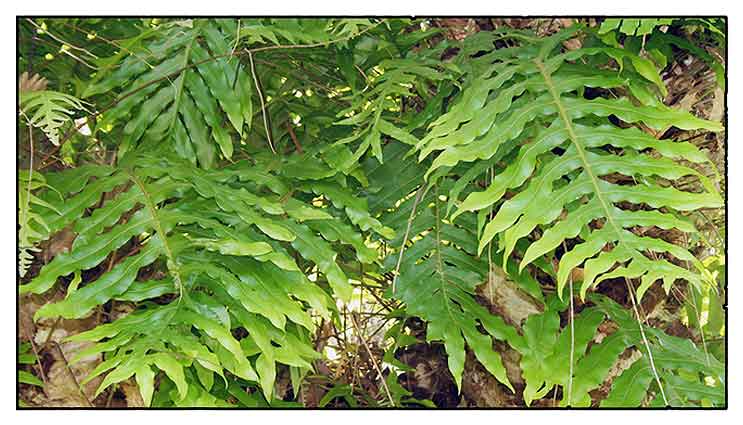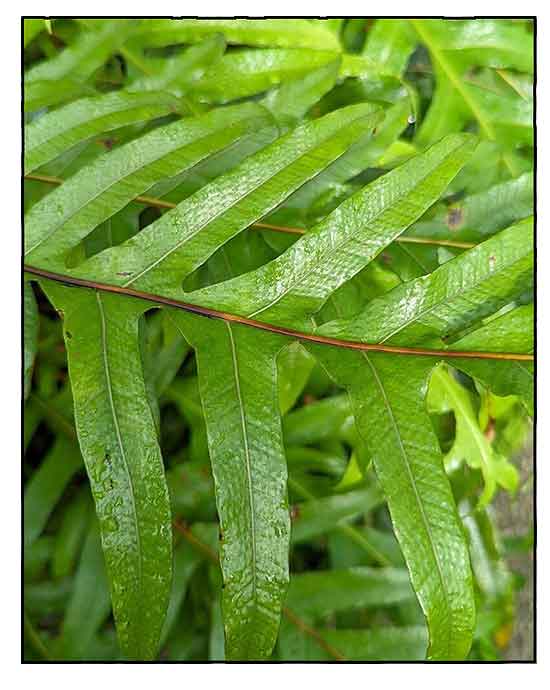
Botany
Drynaria sparsisora is an epiphytic, epilithic or terrestrial fern, rhizome 1-3 cm in diameter, fleshy, densely scaly, smooth and snake-like when old, covered with dark scale bases, the narrow apical portions having broken off; scales peltate, appressed, overlapping, narrowed abruptly above the rounded base, tapering to a narrow, acute, rather spreading apex, 1-11 mm × 1-3 mm, stiff, brown to very dark brown, margins paler and bearing very fine hair-like teeth. Base leaves imbricate, ovate, 10-35 cm × 10-25 cm, margin shallowly or deeply lobed, the lobes rounded; foliage leaves stiffly erect; petiole 5-18 cm long, winged; lamina leathery, deeply pinnatifid, in outline 30-80 cm × 15-30 cm, the lobes strap-like, narrowed slightly towards the base, tapering to a mostly acute apex, 10-30 cm × 1.5-4.5 cm; veins reticulate between prominent main lateral veins. Sori round, 1-2 mm in diameter, in more than two irregular rows between adjacent main lateral veins of the foliage leaves, not or only slightly sunken into the laminal surface; sporangia glabrous. Spores with spines. (1)
 Distribution Distribution
- Native to the Philippines.
- Also native to Bismarck Archipelago, Borneo, Cambodia, Jawa, Lesser Sunda Is., Malaya, Maluku, Myanmar, New Guinea, Queensland, Solomon Is., Sulawesi, Sumatera, Thailand, Vietnam. (2)
- Normally grows spirally on tree trunks in primary or secondary, open or dry forest, from sea level up to 1700 m altitude. Found occasionally in sandy soil or on rocks. (1)
Constituents
- Drynaria sparsisora fronds and rhizomes showed TPC (total phenolic content) of 316.6 and 367.2 mg GAE/100g; IC50 2.01 and 0.81 mg/mL; FRP (ferric reducing power) 2.1 and 2.2 mg GAE/g; TFC (total flavonoid content) 1.0 and 0.1 mg QE/100g, with AEAC (ascorbic acid equivalent antioxidant capacity) of199.9 and 4989.4 mg AA/100g, respectively. (see study below) (3)
Properties
Study suggested antioxidant, tyrosinase enhancing properties.
Parts used
Leaves, roots, saps, rhizomes.
Uses
Edibility
- In Makassar, young leaves eaten as vegetable. (1)
Folkloric
- In the Philippines, used as medicine for the eyes; roots applied to snake bites.
- In Indonesia, roots used as substitute for Areca nut.
- Sap of rhizome mixed with other plant parts for treatment of persistent diarrhea. Bruised rhizome applied externally to reduce limb swelling and to mature boils. Decoction of rhizome mixed with Inocarpus fagiferus is applied to treat virulent gonorrhea. Leaves mixed with honey and Alpingia galanga administered into the nose for treatment of vomiting. (1)
- In India, rhizome paste of Drynaria applied to induce labor and easy childbirth. In diluted form, used to treat ear infections. (1)
Others
- Plaything: In Indonesia, children used the base fronds as kites. (1)
- Masticatory: In Indonesia, roots used as substitute for Areca nut. (1)
Studies
• Antioxidant / Tyrosinase Enhancing / Fronds and Rhizomes: Study evaluated the antioxidant properties of methanolic extracts of fertile fronds and rhizomes of three Drynaria species: D. sparsisora, D. quercifolia, and D. rigidula. Drynaria sparsisora showed no significant difference in TPC and FRP between leaves and rhizomes, and the rhizomes showed significantly higher FRS than the fronds. The TPC of leaves and rhizomes were comparable, but the free radical scavenging capability of the rhizomes were considerably higher than expected based of TPC alone. Study suggests the rhizomes either contain non-phenolic free-radical scavengers, or phenols in the rhizomes are better free radical scavengers than those in the fertile fronds. While fronds of D. quercifolia showed good tyrosinase inhibition, fronds of D. sparsisora showed remarkable tyrosinase enhancement. (3)
Availability
Wild-crafted.
|

![]()





